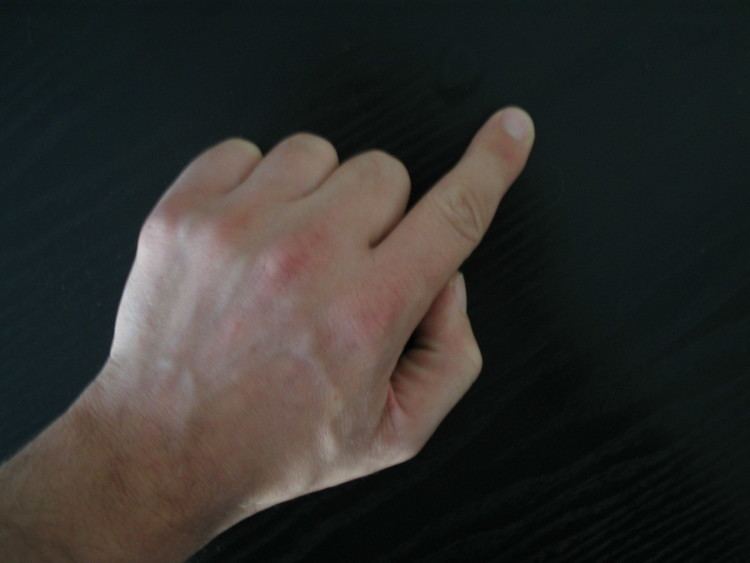Dorlands/Elsevier i_06/12448665 | TA A01.1.00.054 | |
 | ||
Latin Digitus II manus, digitus secundus manus, index | ||
The index finger, (also referred to as forefinger, pointer finger, trigger finger, digitus secundus, digitus II, and many other terms), is the first finger and the second digit of a human hand. It is located between the first and third digits, between the thumb and the middle finger. It is usually the most dextrous and sensitive finger of the hand, though not the longest – it is shorter than the middle finger, and may be shorter or longer than the ring finger – see digit ratio.
Contents
"Index finger" literally means "pointing finger", from the same Latin source as indicate; its anatomical names are "index finger" and "second digit".
Uses
A lone index finger held vertically is often used to represent the number 1 (but finger counting differs across cultures), or when held up or moved side to side (finger-wagging), it can be an admonitory gesture. With the hand held palm out and the thumb and middle fingers touching, it represents the letter d in the American Sign Language alphabet. In sports, it can also represent victory, as some championship-winning teams raise their index finger (often saying "We're number one!") while posing for a championship team photo – oversized foam hands with a single upraised index are also used for this purpose; compare with the victory sign. Most humans find the index finger particularly useful for "picking" their nose. This is done when the index finger is thrust upward into the nasal passage. For the vast majority of computer users, it is the finger most often used to (left) click a mouse, as well as the finger used in the untrained 'hunt and peck' typing style.
Pointing
Pointing with index finger may be used to indicate an item or person.
Around the age of one year, babies begin pointing to communicate relatively complex thoughts, including interest, desire, information, and more. Pointing in human babies can demonstrate the theory of mind, or ability to understand what other people are thinking. This gesture may form one basis for the development of human language. Non-human primates, lacking the ability to formulate ideas about what others are thinking, use pointing in much less complex ways. However, dogs and elephants do understand finger pointing.
In some countries, particularly the Ethnic Malays in Malaysia, pointing using index finger is rude, hence thumb is used instead.
Index finger in Islam
In Islam raising the index finger is used to express the unity of Allah ("there is no God but Allah"). It signifies the Tawhīd (تَوْحِيد) which denotes the oneness of God. This gesture became recently widespread among affiliates of political Islam and Jihadists (supporters of ISIS) mainly for the purpose of propaganda.
In Arabic, the index or fore finger is called Musabbiha (مُسَبِّحة), mostly used with the definite article: al-Musabbiha (الْمُسَبِّحة). Sometimes also this word is used: al-Sabbāha (السَّبّاحة). The Arabic verb سَبَّحَ - which shares the same root as the Arabic word for index finger - means to praise or glorify God by saying: "Subḥāna Allāh" (سُبْحانَ الله).
Gestures in art
As an artistic convention, the index finger pointing at the viewer is in the form of a command or summons. Two famous examples of this are recruiting posters used during World War I by the United Kingdom and the United States.
The index finger pointing up is a sign of teaching authority. This is shown in the depiction of Plato in the School of Athens by Raphael.
Health
According to Japanese, Index finger is connected to urinary bladder and kidney.
